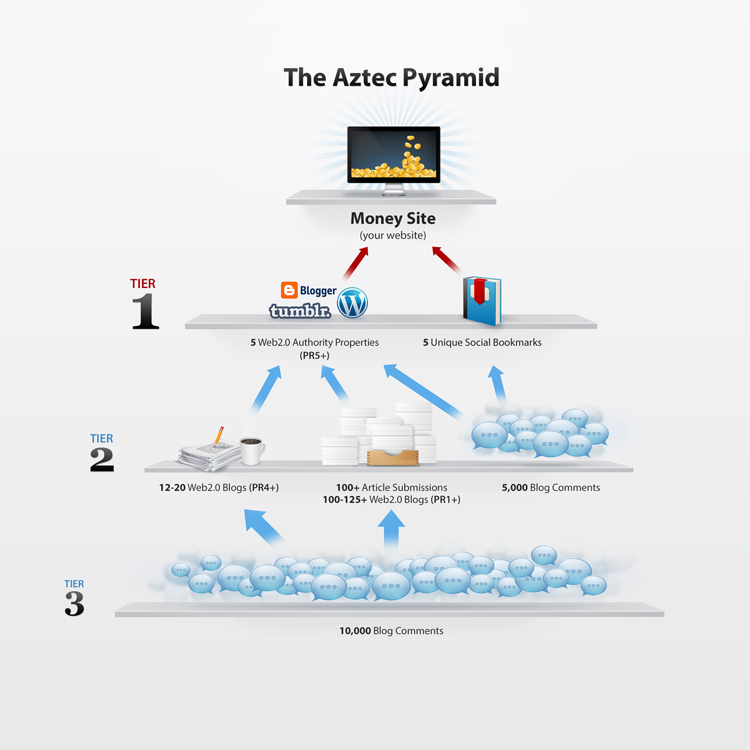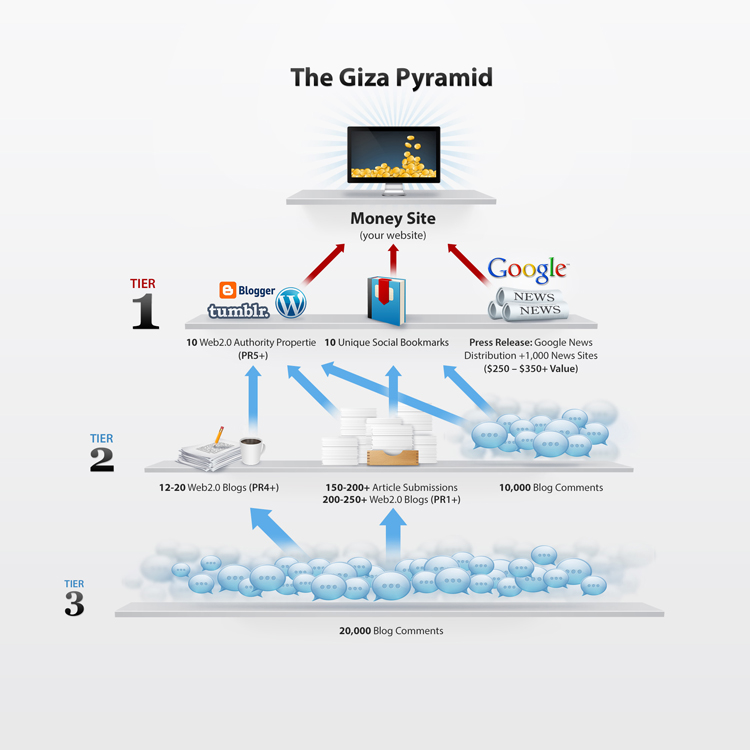Frequently asked questions
1. I Have Some Questions About Your Pyramids (Tiered Link Structures)...
Why is it called a Pyramid? And how does it work, exactly?
A linking pyramid is a strategy used to create maximum "link power" for each actual page created that links to your target website (called the "money site"). These pages are known as "Tier 1" links, and they are above board in every respect - built with excellent, unique content and generally on media-rich platforms, on established authority sites.
Tier 2 links are pages that link to Tier 1 pages, and in some cases, to the Money Site as well. Their purpose is to speed indexing and funnel PageRank ("link juice") to the Tier 1 pages - which then pass all of that "juice" directly to the Money Site. Tier 2 pages are generally built with syndicated or variated content (but still readable), and published on a range of sites including authority sites, Web 2.0 blogs, Article sites, and so on.
Tier 3 links are mass volumes of backlinks created with syndicated/variated content and similar strategies. Their purpose is to drive spidering activity, and PageRank, from literally tens of thousands of pages from across the web to the Tier 2 pages - which in turn condense all of that juice (passing it safely to the Tier 1 pages - which then condense it further, and pass it all solely to your Money Site). Tier 3 links are always created using automated, or software-assisted solutions.
The end result is that the Tier 1 pages end up gaining significant authority and in many cases, PageRank, which is then focused and transferred to the Money Site. Due to the multiple layers of pages and links, the Money Site is insulated from any negative effect that could result from gaining thousands of Tier 3 links, for example, pointing at the website directly.
This makes Pyramids both highly effective - and generally very safe. (But keep in mind that the effect isn't instantaneous. It can take several weeks, sometimes months, for the cumulative effect of the 2nd and 3rd Tiers to kick in, as the search engine spiders find and index all those thousands of backlinks)
Umm... in English, Please?
Well, they say a picture says a thousand words, so here's some graphical diagrams that visually illustrate the two types of Pyramids we offer with LinkitPro:
The Aztec Pyramid

The Giza Pyramid

2. How Many Pyramid Structures Does it Take to Rank a Site for a Keyword?
There is no hard and fast answer to this. We've seen a single pyramid rank websites at the top of page 1 in the SERPs, even in fairly competitive markets. Then again, we've also seen sites where several pyramids were but one of a multitude of different link-building methods required to gain traction, and eventually round over the first page of the SERPs.
Your mileage will definitely vary. We suggest building one pyramid as part of your initial strategy (along with a number of other strategies to create a natural link profile with diversification), and then seeing what happens.
If your site is initially climbing up in the SERPs, and then seems to settle without seeing any further traction for a few weeks, then you may want to run another round of promotions, including one or more Pyramid structures.
3. Tell Me More About the The Press Release in The Giza Pyramid
The press release that is a part of the Giza Pyramid will be written by our team of American writers, using the basic info you provide. This is a REAL Press Release submitted to REAL media sites. We are not doing article directory submissions.
The Press Release will be an SEO press release. This means that the writers will be creating a newsworthy event where most likely none exists. They will be using info found on your website to create the press release.
While they will strive to be as accurate as possible with facts and details, they are writing a fictional press release so some details may not be perfect.
The goal of an SEO press release is to get quality links for you as quickly as possible. You will not have the ability to review or reject the press release prior to it being sent to distribution.
4. PAYMENT FOR SERVICES.
Linkitpro uses an internal currency ("credits"), where the actual cost per credit is one credit = one US Dollar. All services ordered through the Linkitpro dashboard are paid for with such credits, which are initially purchased by you, when you make a deposit.
Deposits, which purchase credits, are a non refundable advance payment for services, which you will then order from the Linkitpro dashboard, You can purchase additional credits at any time.




